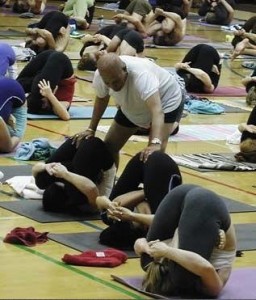Whether you’re a yoga newbie, or a seasoned practitioner accustomed to a routine practice, having the right teachers can make all the difference. If your teacher is good, he or she will not only teach you new things as your practices progresses, but may also inspire and support you through many transformations, on and off the mat. Is your teacher up to par? Here are a few ways to tell.
 Trust Do you trust your yoga teacher has the knowledge to keep your body safe during asanas? Do you feel you can trust them to spot you kicking up into a handstand? Do you often catch your teacher passing off opinion as fact or consistently enforcing ideas that are not in alignment with the spirit of yoga? If you know that your teacher lacks the knowledge to properly teach, you may not find it easy to place your trust in them.
Trust Do you trust your yoga teacher has the knowledge to keep your body safe during asanas? Do you feel you can trust them to spot you kicking up into a handstand? Do you often catch your teacher passing off opinion as fact or consistently enforcing ideas that are not in alignment with the spirit of yoga? If you know that your teacher lacks the knowledge to properly teach, you may not find it easy to place your trust in them.
Positive Speech If your instructor uses derogatory comments in place of positive coaching, you may leave class feeling a little defeated instead of uplifted. The way comments, coaching language and verbal cues are worded is very important because of the way they are perceived. Teachers are encouraged to use language of the heart to ensure they are empowering and uplifting their students. Utilizing words in negative connotations in order to get a point across may leave students feeling belittled and offended.
Adjustments It’s an instructors job to ensure the poses that you work towards are done with the correct foundation and with correct  alignment. The first reason is for safety purposes, to omit injuries in the long run. Second to safety, is for emphasis on the foundation of the posture. Once you develop the right foundation of a pose, you can correctly build up to the next level of that specific postures. If your foundation is wrong you may find yourself relearning the posture before moving onto the next advanced expression of the pose. There are many different approaches and attitudes toward adjustments. Some teachers are very ‘hands-on’ and modify postures by touch. Others coach with words unless a student isn’t understanding the cues, then they resort to the physical approach. With either method, your teacher should ensure that you’re ok with having an adjustment, and should ask if there is any underlying condition or injury impeding your ability to get into a pose. A student should never feel that they are being forced into a posture or that they have no say in being adjusted. And please, ensure the physical contact is appropriate for you.
alignment. The first reason is for safety purposes, to omit injuries in the long run. Second to safety, is for emphasis on the foundation of the posture. Once you develop the right foundation of a pose, you can correctly build up to the next level of that specific postures. If your foundation is wrong you may find yourself relearning the posture before moving onto the next advanced expression of the pose. There are many different approaches and attitudes toward adjustments. Some teachers are very ‘hands-on’ and modify postures by touch. Others coach with words unless a student isn’t understanding the cues, then they resort to the physical approach. With either method, your teacher should ensure that you’re ok with having an adjustment, and should ask if there is any underlying condition or injury impeding your ability to get into a pose. A student should never feel that they are being forced into a posture or that they have no say in being adjusted. And please, ensure the physical contact is appropriate for you.
 Growth Your teacher may be great, and you may find that you enjoy a certain yoga routine, but a yoga teacher’s job is to guide you along a path. This path includes progress and challenge. Some teachers may want to have you around as a student for as long as you like, but an exceptional teacher will be happy for you when you decide to move onto a higher path of yoga. Notice if your teacher is allowing you room for your transformation. Are new poses introduced? Does she often touch on pranayama or meditation? Ensure that your teacher challenges you to continue progression on the path.
Growth Your teacher may be great, and you may find that you enjoy a certain yoga routine, but a yoga teacher’s job is to guide you along a path. This path includes progress and challenge. Some teachers may want to have you around as a student for as long as you like, but an exceptional teacher will be happy for you when you decide to move onto a higher path of yoga. Notice if your teacher is allowing you room for your transformation. Are new poses introduced? Does she often touch on pranayama or meditation? Ensure that your teacher challenges you to continue progression on the path.
 Well Being How do you feel after you leave class? How does your body feel? Are you often dealing with nagging injuries from yoga? Do you dread going to class, but only show up out of self-discipline? A yoga teacher well versed in the science of yoga knows how to ensure you leave class feeling at least better than when you arrived. An exceptional yoga teacher knows how to structure a class properly so that you are able to experience the reciprocity of an asanas routine and not only experience the creative Shakti energy but also revel in the bliss during savasana. A class can be broken down into three to five parts depending on the style. The first part is centering, where people are encouraged to settle into the moment and begin turning their attention inward. Usually thereafter, a few light asanas are offered for warm up to articulate subtle movements in the joints. After that the core asanas of the class are offered followed by a cool-down and savasana. Many teachers incorporate a pinnacle pose to open up to as the climax of class, then cool down afterwards with less strenuous asanas. Classes are structured this way to not only prevent injury but also to utilize the most momentum so a student can experience their own expressive energy. If you’re not getting a well-rounded practice, or leave class feeling worse than when you arrived, your teacher may not know how to properly sequence asanas or structure a class.
Well Being How do you feel after you leave class? How does your body feel? Are you often dealing with nagging injuries from yoga? Do you dread going to class, but only show up out of self-discipline? A yoga teacher well versed in the science of yoga knows how to ensure you leave class feeling at least better than when you arrived. An exceptional yoga teacher knows how to structure a class properly so that you are able to experience the reciprocity of an asanas routine and not only experience the creative Shakti energy but also revel in the bliss during savasana. A class can be broken down into three to five parts depending on the style. The first part is centering, where people are encouraged to settle into the moment and begin turning their attention inward. Usually thereafter, a few light asanas are offered for warm up to articulate subtle movements in the joints. After that the core asanas of the class are offered followed by a cool-down and savasana. Many teachers incorporate a pinnacle pose to open up to as the climax of class, then cool down afterwards with less strenuous asanas. Classes are structured this way to not only prevent injury but also to utilize the most momentum so a student can experience their own expressive energy. If you’re not getting a well-rounded practice, or leave class feeling worse than when you arrived, your teacher may not know how to properly sequence asanas or structure a class.
These are just a few tips to determine whether you have a yoga instructor that’s ok at leading classes or an exceptional teacher that will support your growth and transformation. You will come across teachers that don’t seem to ‘have it’, and you will come across teachers that really know how to guide students on the path. Whether you’re satisfied with your current teacher or not, know that there are phenomenal teachers out there. Hopefully with these tips, you can find one of them.
